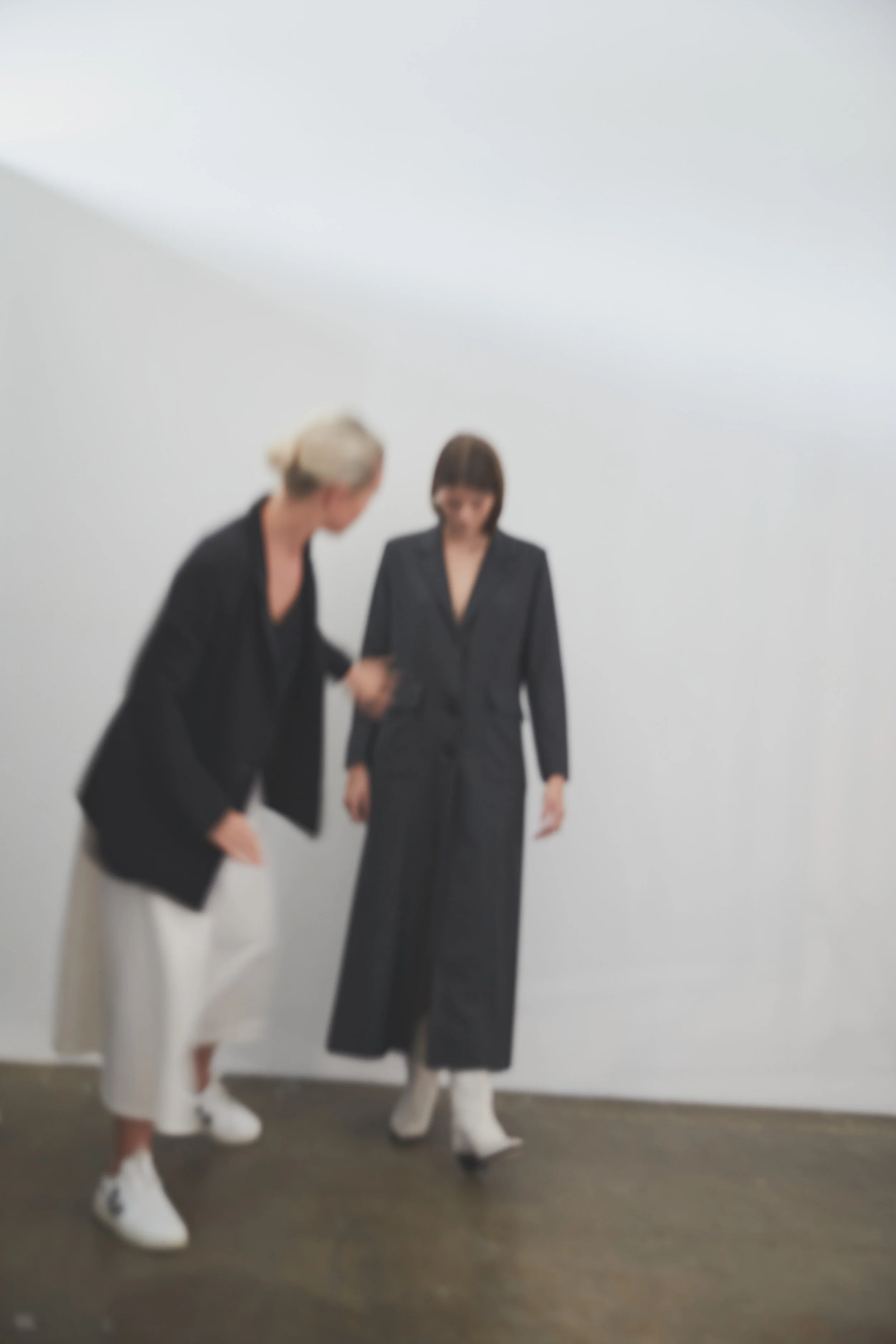How will New Zealand fashion weather the COVID-19 storm? —Natalie Procter
We launched Mina AW20 on Monday the 23rd of March,
the same day lockdown was announced.
So much hard work and so many late nights go into the lead up to launch but the positive response and love that comes from customers once you do, makes it all worth it. All of a sudden, celebrating and trying to sell a collection of clothing felt so inappropriate. The excitement we have for our range and the sense of achievement we’ve been looking forward to is silenced by a global pandemic that nobody could plan for.
We became accustomed to our fate, but the next wave came as the discussion around what ‘essential’ items included. For some businesses, this meant applying with MBIE (Ministry of Business, Innovation and Employment) to ship ‘essential items’. Each day I sat and watched as a few retailers and brands offered essential products. An ethical dilemma was now on my hands. Do I join them and register Mina as an “essential” in this time of crisis? As much as I would have liked the security of cash flow, I figured that as a small business, my overheads were low in comparison. I respect the brands who chose to ship during this time, but when I thought about it honestly; I didn’t feel right for Mina to be on that list. We were told to “stay home, save lives” and this is what seemed most important right now.
“As much as I would have liked the security of cash flow, I figured that as a small business, my overheads were low in comparison. I respect the brands who chose to ship during this time, but when I thought about it honestly; I didn’t feel right for Mina to be on that list. We were told to “stay home, save lives” and this is what seemed most important right now. ”
Knowing that all of our retailers’ stores were also forced to close and their online stores also potentially very quiet, the grim reality set in that they’ll likely be unable to pay their invoices which are due at the end of the month (April); meaning no income during the lockdown period. So, without selling online for a month, and retailer invoices not being paid for some time now either, where were we to go from here?
Initially, I wondered what I’d do during lockdown without the usual activities of sampling or selling being relevant. Although lockdown has bought a lot of financial stress, what it has provided is a rare opportunity to take the time to look inwards and think about our brand.
The first week of lockdown involved strategising how to speak to our customers and community, taking into consideration how uncertain everyone was feeling. The conversation could no longer be product-based, how can we be so commercial at a time when millions of people are fighting this virus? We realised it was a time to dive deep into our brand story, that was something that was still relevant. I guess it was a change in mindset that needed to happen for us to navigate a path that was positive.
For us, our supply chain is key to our business. Without those relationships, our business is nothing. We place so much value on each and every product because we know just how much work has been put in behind the scenes. Since no one is able to produce, there are another 10 or so businesses affected.
We felt it was important to reach out to our supply chain to see how they are going and strengthen each of these relationships. This resulted in an online community series called ‘Every piece has a story’ so that our customers could get to know the people involved behind our garments. Each week we have introduced different people in our supply chain such as our pattern maker and our fabric wholesaler. This not only felt like the right place to shed light but in the future, we hope our customers feel connected to our garments and the items hold greater value to their wardrobe.
Positives that I think are going to come out of COVID - 19 is the ‘support local’ mentality. There is talk of our boarders staying shut for a while and this will mean there is the potential for us to really rely on our local economy and brands may consider moving their production onshore. The flow-on effects of this could be incredible for the creative industry as it would encourage the local production industry to stay alive. The current working conditions are tough for makers as the work can be so inconsistent.
Part of me is scared that society won’t change at all and we will go back to the same harmful ways of fast fashion and cheap offshore manufacturing due to the hurt economy and a peak of unemployment. But then the optimistic side of me thinks of the sense of community, kindness and respect that has risen from this experience. It’s the“buy less, buy well” approach to our business model I think will be important now more than ever. If we can teach the people that are able to afford NZ made products the benefits of doing so, my hope is that people will become more diligent with their money and make more considered and timeless purchase decisions.
Another thing that keeps me hopeful through this time is that we have an opportunity to recalibrate the calendar. Each season the demand for newness increases and puts pressure on designers to drop their collections earlier and earlier in order to get to the front of the pack. The flow-on effect of this is that by the time the garment is relevant (i.e. by the time it’s actually cold enough for coats) the product is going on sale, in preparation for the next seasons’ drop. It’s disorientating and inefficient. Dropping later gives our retailers more time to sell, make more money and drop seasons at a more appropriate time of year.
Essentially, the reason we may be able to push back this calendar is by matter of survival. In March, most designers were selling their next season range SS21 to wholesalers, as production can take up to 6 months to produce. When COVID-19 loomed in, many designers were waiting on wholesale orders to be placed but due to uncertainty, very few retailers felt confident enough to place at all. This meant our minimums for production weren’t met, and now we cannot go forward and produce the next collection. So do we just quit?
“When COVID-19 loomed in, many designers were waiting on wholesale orders to be placed but due to uncertainty, very few retailers felt confident enough to place at all. This meant our minimums for production weren’t met, and now we cannot go forward and produce the next collection. So do we just quit? ”
What I hope to happen is that fellow designers and brands will hold out and revisit this part of the process once we are out of lockdown and the economy begins to settle. Reaching out to retailers post-lockdown and giving them the confidence to place orders means that we may be able to go into production, even if summer arrives in store 2 months delayed. If that’s the case, it actually means we are more in-line with the actual seasons because typically, summer ranges begin dropping in July.
While there are a lot of opinions floating around that direct-to-consumer models are the best way for sustainable businesses to stick around, we need our retailers to help us grow our awareness. It’s a partnership where both wholesale and direct-to-consumer are needed. When I first started Mina, almost 85% of my business was wholesale with my online store and pop-up stores making up the other 15%. Now as I have grown my online store we now trade 50% online and 50% wholesale. Over time it’s become a very equal 50/50 partnership.
The reality is, however, that many retailers never pay on time. Sometimes a payment can be as late as three to five months. Young brands rely on these payments to fund their next season, so you can see how easily a brand can disappear if they have no external financial support. The sad thing is, it’s the young brands that get pushed to the bottom of the queue, it’s the more established brands that are first to be paid.
Fashion is not an easy buy-and-sell business model, there is a huge financial investment placed in producing a collection. Essentially, the previous collection is what funds the next collection, and if that last collection hasn't had the sell through you had planned, well then, you’re in trouble. This is a worry that many New Zealand designers will be facing with this slow start to the winter season sales. Although no designer likes to put their hard work on a discount, this is often the only way to make ends meet and enable us to put a deposit on the next season’s fabric.
“Fashion is not an easy buy-and-sell business model, there is a huge financial investment placed in producing a collection. Essentially, the previous collection is what funds the next collection, and if that last collection hasn’t had the sell through you had planned, well then, you’re in trouble. ”
The pandemic has placed us with an opportunity to disrupt a flawed fashion system and I am excited for community, kindness and respect to form the pillars of our local industry. As I say, we see our ‘buy less, buy well’ approach to business becoming more important every day. We are in this industry as a labour of love, and we’re optimistic that the new economy will place value on face-to-face relationships and have a stronger appreciation for the artisans behind each product.
Words — Natalie Procter of Mina for Her
Follow Mina for Her on Instagram here.



